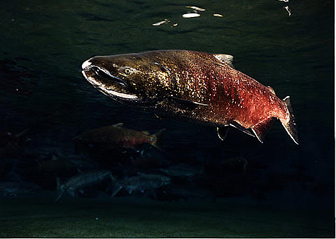Diversity in streams may brace Chinook salmon for climate change
Diversity in streams may brace Chinook salmon for climate change
Hayley Rutger, special to mongabay.com
June 3, 2008
|
|
Chinook salmon face a one-two punch. They have disappeared from several rivers in the western U.S. largely because of human interventions and some populations are threatened or endangered. Numbers of Chinook in California’s Central Valley have dwindled by 88 percent in the past five years, a loss that closed fisheries for 2008 and may cost California’s economy $167 million, according to the state Department of Fish and Game. On top of all this looms a second impact: These salmon will be in hotter water still because of climate change.
However, a new study suggests that some salmon populations may tolerate warming waters better than others, protecting the species as a whole from extinction. Researchers at the National Oceanic and Atmospheric Administration (NOAA) and the University of Washington used a model to predict that salmon whose lives depend mainly on how much water flows in their streams in fall will fare better than those depending mainly on water temperatures in summer. Salmon in separate streams under the same weather may sink or swim in a moderately warmer future, depending on which factors decide their fate.
“There’s a lot of life-history variation in salmon in general, and particularly in the Chinook,” said NOAA researcher and study coauthor Lisa Crozier. “That’s certainly why [the Chinook have] lasted this long.” Human threats such as pollution, fishing, and hydroelectric dams have damaged several salmon populations, but their diverse behaviors and needs ensure that some carry on. The study shows that this variation—even among the most similar populations—probably will cushion them against future climatic effects, Crozier said.
 The photo shows a mature Chinook salmon in the Hanford Reach of the Columbia River System in Washington state. Courtesy of the Washington State Department of Ecology. |
The researchers predicted salmon abundances during warming through 2040 by simulating four salmon populations, using the fish in Idaho’s Salmon River Basin as their model. For two populations, water temperatures in summer streams—where young salmon stay their first year—were the main difference between life and death. The other two populations depended on stream flow during the autumn, when the vulnerable, first year salmon are still upriver. The model drew upon 14 years of actual survival data gathered on local Chinook salmon by biologists in the field.
The study also split the fish’s lives into five stages, which depended on their ages, locations, and surrounding conditions. The salmon populations each lived by their own rivers’ rules, uniting only in the ocean. This model’s intricacy is more sophisticated than for most other animals, Crozier said, because scientists know the Chinook’s life cycle very well.
For the temperature changes at Earth’s surface, the researchers studied warmings of both 1.7 degrees Celsius (3.1°F) and 2.6 degrees C (4.7°F) by the year 2040, using global simulations from the most recent assessment of an international panel of climatologists. In their model, these climate alterations drove the temperatures and flow patterns of the streams, like one gear in a machine turns another.
When the virtual streams warmed and shrank, the salmon populations shrank by up to 37 percent under moderate warming and up to 50 percent in the severe case. These statistics “should be taken with a grain of salt,” said Crozier. Both adult and young salmon may lose crucial cool water habitats, or they might have problems with reproduction, increased predation, and other factors when waters warm, she said, but their flexible physiologies and behaviors might compensate. The first warmer years even might help the fish mature more quickly than their usual 3-6 years. “There may be mitigating factors, but it’s still going to be a big deal,” Crozier said.
But even with moderate warming, the Chinook salmon in these populations had a decent chance of “quasi-extinction”—dropping to such low numbers a fluke storm could wipe them out, she noted.
A bigger deal was the survival rift between populations. With mild warming, the groups depending on water temperature lost nearly twice as many salmon as the groups depending on stream flow. Hotter temperatures shrank that gap, suggesting that a more intense global warming would leave no winners.
The mechanism protecting one group from moderate warming is still unclear. “Certainly we have to do more experiments to better understand what’s really going on,” said Crozier. NOAA is now applying a scientific magnifying glass to Chinook salmon and other sensitive fish species to assess climate effects, she said.
The new study has merits but is limited in a fundamental way, said Louis Botsford, a population biologist at the University of California, Davis, who works with marine reserves. “This study only looks at half the problem,” Botsford said. “There could be a dramatic change in the ocean in addition to the dramatic change on land.” Changes in the ocean—where salmon from these populations spend age one to maturity (three to six years)—are harder to simulate because ocean temperatures follow complex patterns, Botsford said. Still, although oceans might trump streams in the game of salmon survival, scientists should keep performing such studies, he added.
Crozier agreed that the ocean is full of surprises, including how warming might change ocean salmon migrations, but she said the differences between salmon populations while they’re upriver are still important. When it comes to global warming, “I think most species are very resilient if they can maintain those refugia, those pockets of diversity, and they don’t lose all their flexibility.” Further damming, polluting, and overfishing of rivers will only weaken those protective shields, she said.
Citation: Lisa G. Crozier, Richard W. Zabel and Alan F. Hamlet (2008). “Predicting differential effects of climate change at the population level with life-cycle models of spring Chinook salmon”. Global Change Biology, February 2008.
Hayley Rutger is a graduate student in the Science Communication Program at the University of California, Santa Cruz.